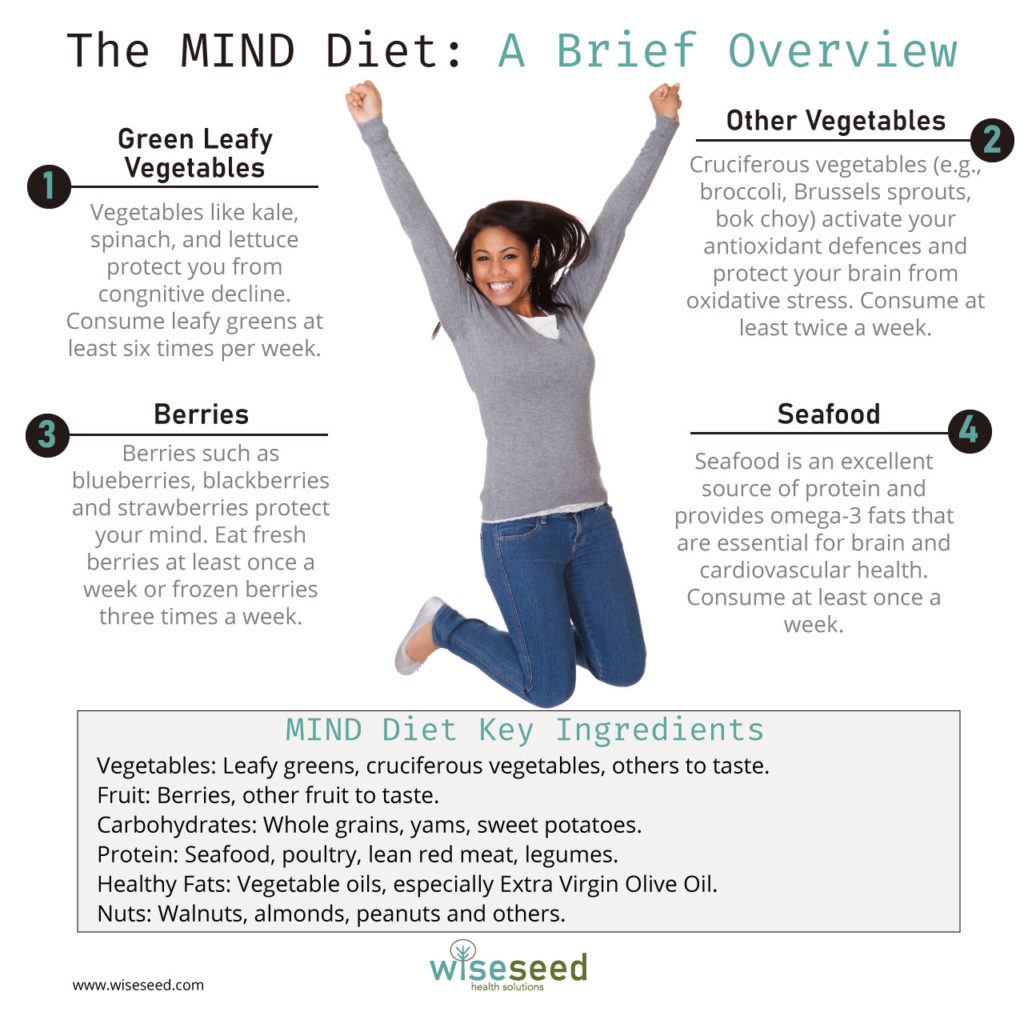Building an Anti-Frail Mind: A Brief Overview of The MIND Diet

Why I Love the MIND DIET
I love the MIND diet. Why? Because the MIND diet preserves your mind, protects your brain against dementia and stroke, all while reducing the risk of cancer and premature death. What’s not to love about that?
Below I provide a brief overview of the MIND diet to help keep you on the anti-frail path.
What is the MIND Diet?
The MIND diet combines the Mediterranean and DASH diets, which protect you from cognitive decline (1, 2). However, the MIND diet emphasizes four ingredients that have demonstrated neuroprotective effects in humans (3, 4). These are:
(1) green leafy vegetables
(2) other vegetables
(3) berries
(4) seafood
The Nice List
For the MIND diet to work for you, you have to make the majority of your meals from the following foundational ingredients.
Leafy Greens
Leafy green vegetables are a brain superfood because they contain many nutrients crucial for brain health. More importantly, consumption of leafy green vegetables reduces the rate of cognitive decline (6)
When selecting your leafy greens, the darker, the better, as more beneficial phytochemicals are present within the darker leaves. Also, you’ll want to include an oil-based salad dressing because many of the bioactive compounds in leafy greens are fat-soluble.
Examples include kale (of course), spinach, lettuce, and spring greens. Eating one cup of leafy greens per day is sufficient to protect your mind, but more is likely better, so don’t feel that you should hold back on the salad. On the contrary, go for it.
Other Vegetables
Of course, leafy greens aren’t the only vegetable in town. Therefore, you should include various vegetables in your diet to obtain the full spectrum of vitamins, minerals, and phytochemicals for maximal health (7).
Of particular note are the cruciferous vegetables (7). Cruciferous vegetables belong to the Brassicaceae family, including broccoli, Brussels sprouts, cabbage, and bok choy. These vegetables activate your antioxidant defense systems, protecting you from the effects of oxidative stress.
Of course, the cruciferous and other vegetables also provide essential nutrients such as vitamins, fiber, minerals, and bioactive compounds. Also, they taste great and add color to your dishes.
For maximal anti-aging effect, eat cruciferous vegetables at least twice per week and other vegetables as desired.
Berries
Animal studies identify berries (specifically blueberries, strawberries, blackberries, and cranberries) as a brain superfood (7). Fortunately, epidemiological studies in humans support the results from animal studies by showing that regular berry consumption slows your rate of cognitive decline (7).
How do berries protect your mind? Berries are rich in carotenoids and flavonoids, bioactive chemicals that possess antioxidant and anti-inflammatory properties (7). Unfortunately, the freezing process reduces the level of carotenoids and flavonoids found in frozen berries. Therefore, you should consume fresh berries whenever possible.
You should eat one cup of fresh berries each week (7). However, if you only have access to frozen berries, consume 2-3 cups of frozen berries each week to compensate for the loss of bioactive compounds during processing. For frozen berries, smoothies are the perfect berry delivery system.
Other Fruits
There is no evidence linking fruit consumption (other than berries) with protection against cognitive decline (7). However, there is plenty of evidence showing that the consumption of fruit protects you against cancer, osteoporosis, and cardiovascular disease (7).
Because fruits contain significant sugar levels, if you are concerned about maintaining or losing weight, you should swap fruit for vegetables whenever possible.
Whole Grains
First, what are whole grains? Whole grains include the bran, sperm, and endosperm parts of the grain. In contrast, processed grain consists of only the endosperm.
Because whole grains have the bran and sperm parts of the grain, they provide minerals, B vitamins, E vitamins, and carbohydrates. Whole grains are also an excellent source of fiber. Consuming whole grains reduces your risk of developing hypertension, diabetes, obesity, and coronary heart disease, reducing your risk of cognitive decline (7).
Several popular diets eliminate carbohydrates, such as the ketogenic diet, claiming that removing carbohydrates from your diet provides health benefits such as reduced inflammation. However, studies have shown that including whole grains in your diet reduces inflammation, protects you from oxidative stress, decreases your risk of cardiovascular disease, and improves your cognition (7).
If you are gluten-intolerant, don’t worry, there are plenty of gluten-free options available. For example, corn, rice, sorghum, and quinoa are all gluten-free. Quinoa also happens to be a source of complete protein!
You can eat whole grains three times a day.
Yams and Sweet Potatoes
Yams and sweet potatoes are excellent sources of low-GI carbohydrates (8). Further, both yams and sweet potatoes are good sources of vitamins and minerals.
In contrast, white potatoes have a high glycemic index (8). Foods with a high glycemic index cause a spike in blood sugar levels after eating that, over time, contributes to chronic disease. Thus, you should avoid consuming white potatoes.
Seafood
Not only is seafood an excellent source of complete protein, but it also provides you with essential omega-3 fatty acids!
Omega-3 fatty acids are essential for healthy brain functioning (5). They are also crucial for cardiovascular health (5). In addition, many studies have shown that including just one seafood meal per week significantly lowers your risk of dementia. But, of course, you can eat more than one seafood meal per week.
Poultry
Poultry is an excellent source of complete protein and supports brain health by providing you with B vitamins and tryptophan (5). However, it’s best to remove the skin after cooking to minimize your consumption of saturated fat.
Lean Red Meat
The problem with red meat is the high amount of saturated fat present in many cuts of meat (5). However, if you stick to lean cuts, red meat is an excellent source of complete protein without the risk of saturated fat.
Legumes
Lentils (i.e., beans, lentils, chickpeas, and peas) are an excellent source of low-fat protein and B vitamins (5). Lentils also contain tons of dietary fiber. However, a concern with lentils is that they are low in certain amino acids and are not a complete protein source, unlike animal protein sources such as seafood and poultry.
However, you can satisfy your dietary amino needs by consuming a balanced diet that includes nuts and grains (5). Alternatively, you can use legumes to supplement your poultry, seafood, and red meat diet.
Vegetable Oils
Vegetable oils are an essential source of healthy fats and an excellent source of vitamin E (5). In addition, vegetable oils such as extra-virgin olive oil contain bioactive polyphenols (5). Further, walnut and flaxseed oil provide essential omega-3 fatty acids.
Vitamin E and omega-3 fatty acids improve brain health and may reduce your risk of cognitive decline. In addition, there is increasing evidence from the Mediterranean diet that extra-virgin olive oil protects you against dementia. For this reason, make olive oil your primary source of healthy fats (5). However, the olive oil industry is largely unregulated, so only buy extra virgin olive oil certified by the Australian Olive Association.
Some nutrient-dense oils are corn, grapeseed, olive, rapeseed, sesame, sunflower, and walnut oil. Use them in salad dressing to provide healthy fats and help you absorb fat-soluble plant nutrients.
Nuts
Nuts are also an excellent source of healthy fats. They also provide a host of other nutrients, such as vitamin E and vitamin B. Of all the nuts, walnuts have the most beneficial fats and were an integral part of the Mediterranean diet that preserved cognitive function (5).
You can consume a handful of nuts 2-5 times a week. However, be cautious with your nut consumption. Because nuts are calorie-dense, eating too many nuts may cause you to gain unwanted weight (been there!).
The Naughty List
What you don’t eat is as important as what you do eat. The following is a list of foods that harm your brain and are best avoided (5).
- Fried and Fast Food
- Whole-fat cheese
- Pastries and Sweets
Take-Home Message
The MIND diet is a tasty and straightforward approach for maintaining a healthy brain. However, the key to dietary success is consistency. Therefore, most of your meals should be made from ingredients exclusively found within the Nice list, with only occasional forays into the Naughty list.

References and Further Reading
1. P. J. Smith et al., Effects of the dietary approaches to stop hypertension diet, exercise, and caloric restriction on neurocognition in overweight adults with high blood pressure. Hypertension 55, 1331-1338 (2010).
2. E. H. Martínez-Lapiscina et al., Mediterranean diet improves cognition: the PREDIMED-NAVARRA randomised trial. J Neurol Neurosurg Psychiatry 84, 1318-1325 (2013).
3. M. C. Morris et al., MIND diet slows cognitive decline with aging. Alzheimers Dement 11, 1015-1022 (2015).
4. M. C. Morris et al., MIND diet associated with reduced incidence of Alzheimer’s disease. Alzheimers Dement 11, 1007-1014 (2015).
5. M. C. Morris, Nutrition and risk of dementia: overview and methodological issues. Ann N Y Acad Sci 1367, 31-37 (2016).
6. M. C. Morris et al., Nutrients and bioactives in green leafy vegetables and cognitive decline: Prospective study. Neurology 90, e214-e222 (2018).
7. M. C. Morris, Diet for the Mind: The Latest Science on What to Eat to Prevent Alzheimer’s and Cognitive Decline. (Macmillan, 2018).
8. F. S. Atkinson, K. Foster-Powell, J. C. Brand-Miller, International tables of glycemic index and glycemic load values: 2008. Diabetes care 31, 2281-2283 (2008).
Acknowledgments
Images created by AndreyPopov and Nicholas77
Disclaimer
The material displayed on this website is provided without any guarantees, conditions or warranties as to its accuracy.
Information written and expressed on this website is for education purposes and interest only. It is not intended to replace advice from your medical or healthcare professional.
You are encouraged to make your own health care choices based on your own research and in conjunction with your qualified practitioner.
The information provided on this website is not intended to provide a diagnosis, treatment or cure for any diseases. You should seek medical attention before undertaking any diet, exercise, other health program or other procedure described on this website.
To the fullest extent permitted by law we hereby expressly exclude all warranties and other terms which might otherwise be implied by statute, common law or the law of equity and must not be liable for any damages whatsoever, including but without limitation to any direct, indirect, special, consequential, punitive or incidental damages, or damages for loss of use, profits, data or other intangibles, damage to goodwill or reputation, injury or death, or the cost of procurement of substitute goods and services, arising out of or related to the use, inability to use, performance or failures of this website or any linked sites and any materials or information posted on those sites, irrespective of whether such damages were foreseeable or arise in contract, tort, equity, restitution, by statute, at common law or otherwise.

Ten Minutes is All You Need
Research has shown that ten minutes of moderate-to-vigorous exercise performed each day is enough to significantly reduce your risk of early death.





